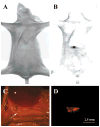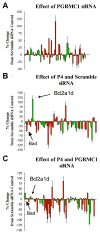Progesterone signaling mediated through progesterone receptor membrane component-1 in ovarian cells with special emphasis on ovarian cancer
- PMID: 21371489
- PMCID: PMC3129485
- DOI: 10.1016/j.steroids.2011.02.011
Progesterone signaling mediated through progesterone receptor membrane component-1 in ovarian cells with special emphasis on ovarian cancer
Abstract
Various ovarian cell types including granulosa cells and ovarian surface epithelial cells express the progesterone (P4) binding protein, progesterone receptor membrane component-1 (PGRMC1). PGRMC1 is also expressed in ovarian tumors. PGRMC1 plays an essential role in promoting the survival of both normal and cancerous ovarian cell in vitro. Given the clinical significance of factors that regulate the viability of ovarian cancer, this review will focus on the role of PGRMC1 in ovarian cancer, while drawing insights into the mechanism of PGRMC1's action from cell lines derived from healthy ovaries as well as ovarian tumors. Studies using PGRMC1siRNA demonstrated that P4's ability to inhibit ovarian cells from undergoing apoptosis in vitro is dependent on PGRMC1. To confirm the importance of PGRMC1, the ability of PGRMC1-deplete ovarian cancer cell lines to form tumors in intact nude mice was assessed. Compared to PGRMC1-expressing ovarian cancer cells, PGRMC1-deplete ovarian cancer cells formed tumors in fewer mice (80% compared to 100% for controls). Moreover, the number of tumors derived from PGRMC1-deplete ovarian cancer cells was 50% of that observed in controls. Finally, the tumors that formed from PGRMC1-deplete ovarian cancer cells were about a fourth the size of tumors derived from ovarian cancer cells with normal levels of PGRMC1. One reason for PGRMC1-deplete tumors being smaller is that they had a poorly developed microvasculature system. How PGRMC1 regulates cell viability and in turn tumor growth is not known but part of the mechanism likely involves the regulation of genes that promote cell survival and inhibit apoptosis.
Copyright © 2011 Elsevier Inc. All rights reserved.
Conflict of interest statement
Disclosure Statement
The author does not have any actual or potential conflicts of interest.
Figures





References
-
- Salzberg M, Thurlimann B, Bonnefois H, Fink D, Rochlitz C, von Moos R, Senn H. Current concepts of treatment strategies in advanced or recurrent ovarian cancer. Oncology. 2005;68:293–298. - PubMed
-
- Fauvet R, Dufournet Etienne C, Poncelet C, Bringuier AF, Feldmann G, Darai E. Effects of progesterone and anti-progestin (mifepristone) treatment on proliferation and apoptosis of the human ovarian cancer cell line, OVCAR-3. Oncol Rep. 2006;15:743–748. - PubMed
-
- Syed V, Mukherjee K, Godoy-Tundidor S, Ho SM. Progesterone induces apoptosis in TRAIL-resistant ovarian cancer cells by circumventing c-FLIPL overexpression. J Cell Biochem. 2007;102:442–452. - PubMed
Publication types
MeSH terms
Substances
Grants and funding
LinkOut - more resources
Full Text Sources
Other Literature Sources
Medical
Research Materials

